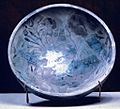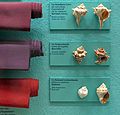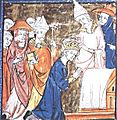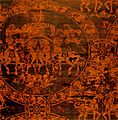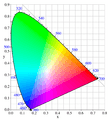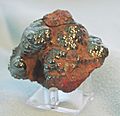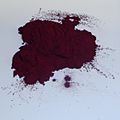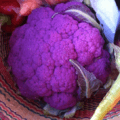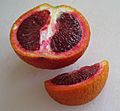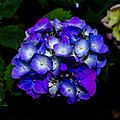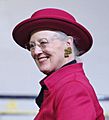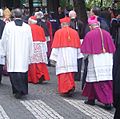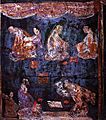Purple facts for kids
| This box shows the color purple. |
|---|
Purple is a beautiful colour that mixes blue and red. It's a color often seen in nature, like in flowers and fruits, and has been important throughout history. The word purple was first used in English around the year 975.
Contents
What Makes Purple Special?
Purple is unique because it's a mix of a cool color (blue) and a warm color (red). This makes it feel both calm and exciting at the same time!
Purple vs. Violet and Indigo
Sometimes people get purple, indigo, and violet mixed up. Here's a simple way to think about it:
- Violet is a pure color found in the rainbow (like the colors from a prism). It's very close to blue.
- Indigo is a deep blue-purple color, often seen between blue and violet in a rainbow.
- Purple is usually seen as a mix of red and blue, and it can be made in many different shades, from light lavender to deep plum.
Purple Through History
Purple has a very rich history and was often a color for kings, queens, and very important people.
Tyrian Purple: The Royal Color
For thousands of years, a special kind of purple called Tyrian purple was the most famous and expensive dye.
- It was made from tiny sea snails called murex. It took thousands of snails to make just a small amount of dye!
- Because it was so hard and costly to make, only the richest people, like emperors and kings, could afford to wear it.
- In Ancient Rome and Ancient Greece, wearing Tyrian purple showed that you were very powerful and important.
- Even in the Byzantine Empire and later in Europe, purple robes were a sign of royalty and high rank.
Purple in Religion
Purple has also been an important color in many religions.
- In the Roman Catholic Church, bishops and cardinals often wear purple robes.
- It can represent royalty, wealth, and sometimes even sadness or preparation.
Purple in Art and Culture
Artists have used purple to create different moods and feelings in their work.
- Many famous painters, like Gustav Klimt, used purple in their portraits.
- The musician Prince made purple a big part of his image, especially with his famous album and movie Purple Rain. He even encouraged his fans to wear purple to his concerts!
- The color purple was also important in the Women's Suffrage movement, which fought for women's right to vote. It symbolized loyalty and purpose.
How We See Purple Today
Today, purple is everywhere, from clothes to technology.
Purple on Screens
When you see purple on a computer or TV screen, it's usually made by mixing red and blue light. This is how screens create all the colors you see!
Purple in Nature
Purple is a very common color in nature, especially in plants and animals.
- Many flowers, like lavender, lilac, pansy, and iris, are purple.
- Some fruits and vegetables, like blackberries, purple cauliflower, and eggplant, get their purple color from natural pigments called anthocyanins. These pigments can change color depending on how acidic or basic they are.
- You can also see purple in animals, like the purple frog or the violet-backed starling.
Purple in Landscapes
Sometimes, mountains can look purple, especially at sunset or sunrise. This happens because of how light scatters in the air, making distant objects appear bluer or purpler. This effect is called aerial perspective.
Images for kids
-
Byzantine Emperor Justinian I wearing Tyrian purple in a 6th-century mosaic.
-
The musician Prince made purple a central part of his career, especially with his famous album Purple Rain.
-
The Cadbury logo, which is a well-known purple.
-
The emblem of King Alfonso IX of León from the 12th century.
-
A painting of a man wearing an all-purple toga picta from an Etruscan tomb.
-
Empress Theodora, wife of Emperor Justinian I, dressed in Tyrian purple.
-
An 11th-century Byzantine robe dyed with Tyrian purple.
-
A medieval painting of Emperor Charlemagne's coronation, with bishops and cardinals in purple.
-
A piece of the shroud Charlemagne was buried in, made of gold and Tyrian purple.
-
A 12th-century painting of Saint Peter making Hermagoras a bishop, who is wearing purple.
-
In the Ghent Altarpiece, popes and bishops are shown wearing purple robes.
-
A portrait by Gustav Klimt showing a woman with a purple hat.
-
George VI wearing purple in his official portrait.
-
The coronation portrait of Elizabeth II and Philip, Duke of Edinburgh, showing different shades of purple.
-
A program from the 1913 Woman Suffrage Procession.
-
A pennant from the Women's Suffrage movement.
-
Purple colors on a screen are made by mixing red and blue light using the RGB color model.
-
Ancient cave paintings in Lascaux used manganese pigments for red-purple colors.
-
A swatch of cobalt violet, a color used by Impressionist painters.
-
Blackberries were sometimes used to make purple dye long ago.
-
The male violet-backed starling has bright purple feathers.
-
The purple frog is a unique amphibian from India.
-
The purple sea urchin from Mexico.
-
A purple heron flying in South Africa.
-
A purple finch from North America.
-
The Lorius domicella, or purple-naped lory, from Indonesia.
-
The purple colors in these fruits, vegetables, and flowers come from natural pigments called anthocyanins.
-
Anthocyanins can be red, purple, or other colors depending on their pH level.
-
Anthocyanins also give copper beech trees and autumn leaves their purple color.
-
A beautiful purple pansy flower.
-
"Blue" hydrangea flowers are often actually purple.
-
An artichoke flower in blossom.
-
Syringa vulgaris, or lilac blossoms.
-
Medicago sativa, also known as alfalfa or lucerne.
-
The Aster alpinus, or alpine aster, a purple flower.
-
Lavender flowers.
-
A purple rose.
-
Wisteria flowers, which are a pale purple.
-
Salsify, a plant with purple flowers.
-
Purple Mountain near Killarney, Ireland.
-
A purple postage stamp honoring Queen Elizabeth II.
-
Queen Margrethe II of Denmark in 2010.
-
In the Roman Catholic Church, cardinals wear scarlet and bishops wear amaranth.
-
Katharine Jefferts Schori, a Presiding Bishop of the Episcopal Church of the United States.
-
Han purple and Han blue were synthetic colors made in China during the Han dynasty.
-
Emperor Komyo of Japan. Purple was a color for royalty in Japan and China.
See also
 In Spanish: Púrpura para niños
In Spanish: Púrpura para niños






